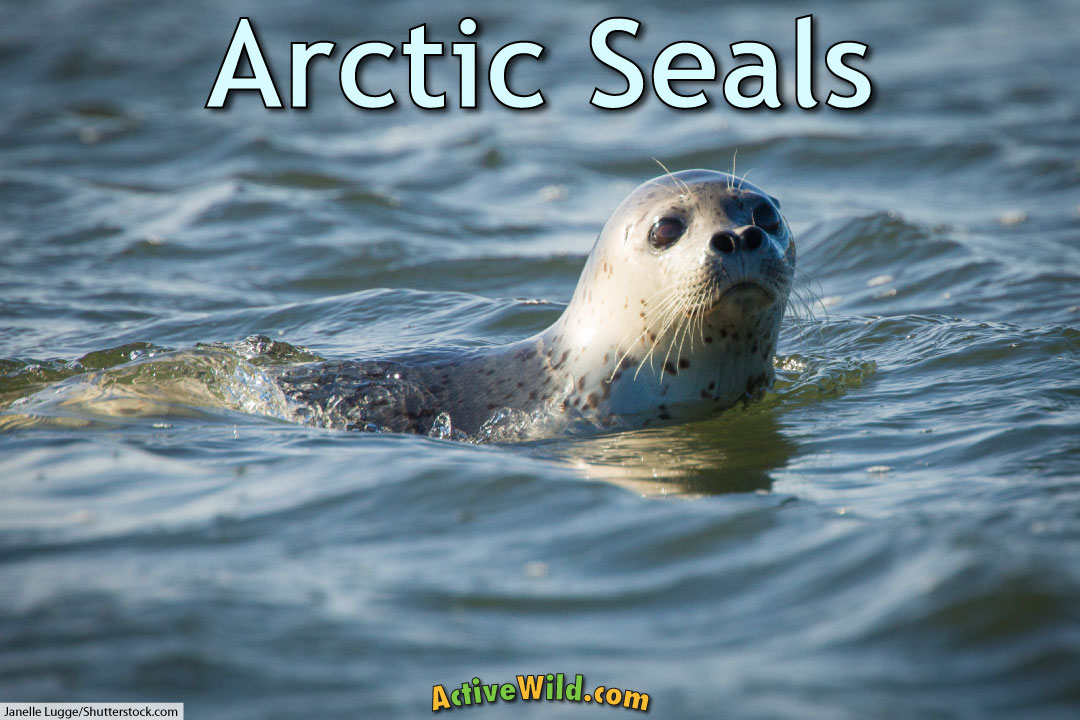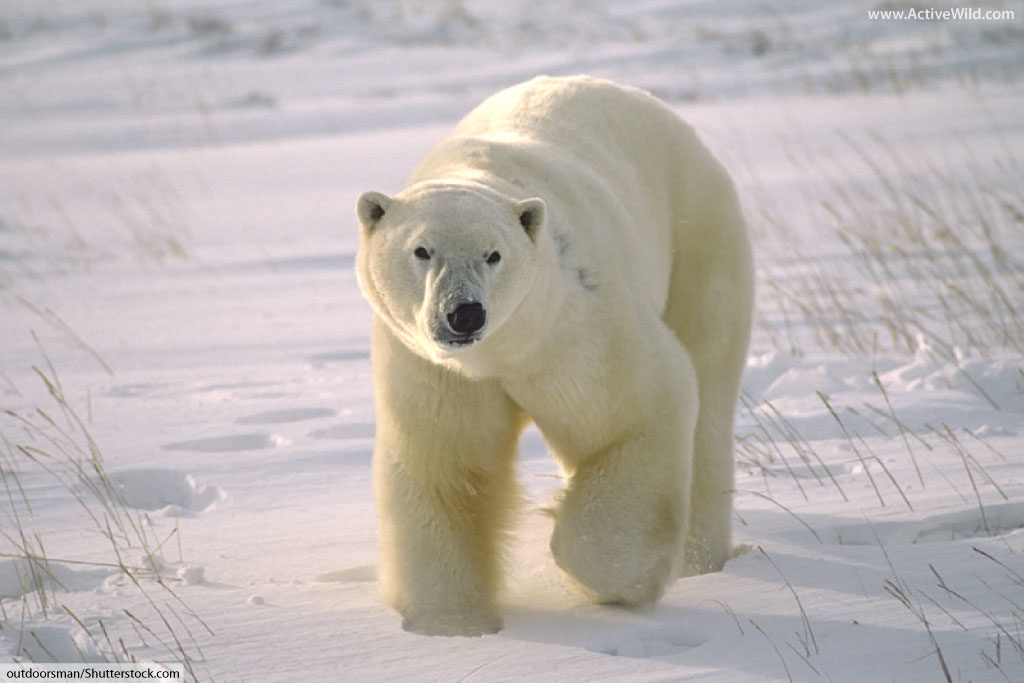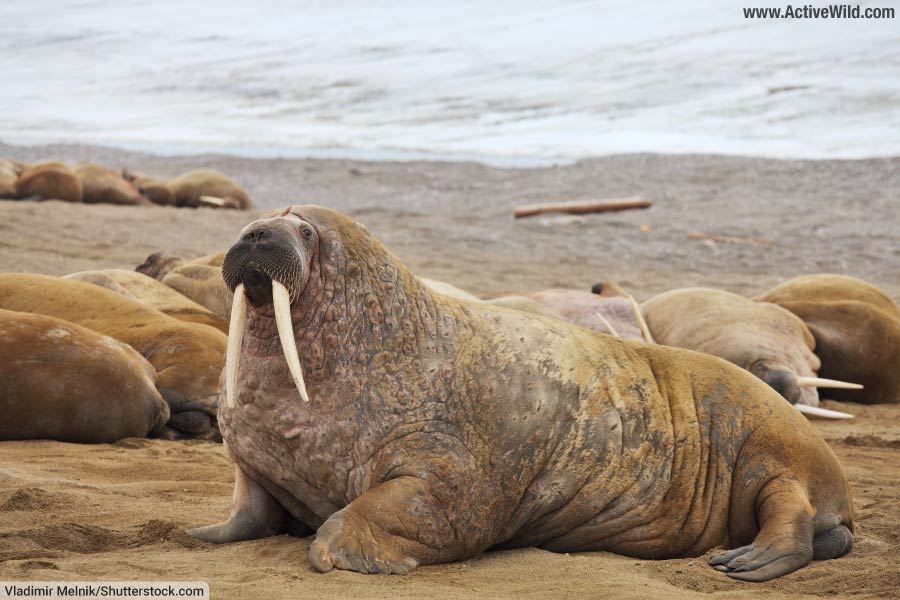Arctic seals list with pictures & facts on each species. On this page you’ll find information on all six seals that live in the Arctic (seven including the walrus).
***Be sure to watch the video of the hooded seal - one of the strangest Arctic animals of all!***
Page Index
- Introduction: What Is A Seal?
- Arctic Seals List
- Bearded Seal
- Harp Seal
- Hooded Seal
- Ribbon Seal
- Ringed Seal
- Spotted Seal
- Walrus
Introduction
Seals are among the few animals able to survive on the frozen coastlines and continuously expanding and contracting sea ice of the Arctic.
What Is A Seal?
A seal is a carnivorous marine mammal with numerous adaptations for a semi-aquatic lifestyle.
Seals, together with sea lions and walruses, are members of a group of animals known as Pinnipedia. Members of this group are known as pinnipeds.
Seal Families
There are 36 living pinniped species, divided between 3 families (Data: Catalogue of Life)
- Odobenidae (1 species) The only species in this family is the walrus.
- Otariidae (16 species) Members of this family are also known as the ‘eared seals’ on behalf of their visible external ears. This family contains sea lions and fur seals.
- Phocidae (19 species). The ‘true seal’ family. Members of this family are also known as ‘earless seals’ because their ears are not visible externally.
Only 7 pinnipeds (6 true seals and the walrus) are found in the Arctic.
Unlike whales, dolphins and porpoises, pinnipeds are not fully aquatic. They still rely on land (or, in the case of several Arctic seals, ice) in order to give birth and raise their pups.
Although seals spend most of their lives in the water, they regularly come onto land; a process known as ‘hauling out’.
However, with flippers for limbs, a layer of blubber to insulate them from the cold, and many other adaptations for swimming and diving, pinnipeds are much more at home in the water than they are on land.
Related Animals
Seals are descended from land mammals. The pinnipeds branched off from their land-based relatives 50 million years ago. The closest living land relatives of seals are animals such as dogs, bears and weasels. Seals are in the same group – Caniformia – as these animals.
(Caniformia is a suborder. You can find out more about animal groups such as suborders, orders, families and species on this page: Animal Classification.)
Arctic Seals
There are six species of seal found in the Arctic. They are: the bearded seal, harp seal, hooded seal, ribbon seal, ringed seal and spotted seal.
The walrus is the only other pinniped found in the Arctic.
The eared seals found furthest north are the northern fur seal and the Steller sea lion. Although both are present in sub-Arctic regions, neither is a true Arctic seal.
List Of Seals That Live in the Arctic
- Bearded Seal
- Harp Seal
- Hooded Seal
- Ribbon Seal
- Ringed Seal
- Spotted Seal
- Walrus (not a true seal, but a pinniped)
Scroll down for information on each species.
Bearded Seal
- Other Names: Square flipper seal
- Scientific Name: Erignathus barbatus
- Conservation Status: Least Concern
The bearded seal is named for its long, bushy white whiskers. Its body is uniform dark grey, and individuals are only rarely marked with faint spots. The species has square front flippers, which give the species its alternative name of square flipper seal.
The bearded seal is the largest of the Arctic seals (but is not as big as the walrus). It grows to lengths of up to 8 ft. (2.43 m), and weights of up to 948 lb. (430 kg). Females are slightly longer and heavier than males.
Bearded seal pups are born on the floating sea ice. The mother spends very little time with the pup, which is able to swim within hours of being born. This may be a tactic to minimize the risk of predation by polar bears; a lone cub is harder to spot on the ice floe than it would be if the mother was also present. The cub stays with its mother for only 3 weeks.
The bearded seal is known for its haunting underwater cry. Sounding like a series of ghostly moans, the call can be heard up over 18 miles (30 km) away. It is thought that the bearded seal calls to attract mates and to define its territory.
Harp Seal
- Other Name(s): Saddleback seal
- Scientific Name: Pagophilus groenlandicus
- Conservation Status: Least Concern
The harp seal can be identified by the black V, or ‘harp-shaped’ patch on its back. The rest of the body is silver grey, and the face is black.
The harp-shaped marking (from which the species gets its name) is only present on adults. Pups are born with a coat of white fur. This disappears after around 3 weeks. As the seal matures the dark spots on its back slowly grow and merge together, forming the harp shape.
The species grows to lengths of around 6 ft. 7 in (2 m). Males are slightly bigger than females.
A highly social animal, the harp seal lives in groups of several hundred. During the breeding season the species congregates into groups numbering several thousand.
Harp seals live on the edge of the Arctic sea ice, following it as it seasonally expands and contracts. The species will migrate up to around 4,000 km (2,500 mi) between its breeding and feeding grounds every year.
Hooded Seal
- Other Name(s): Bladder-nosed seal
- Scientific Name: Cystophora cristata
- Conservation Status: Vulnerable
You can see footage of this strange-looking Arctic seal below:
From a distance, the hooded seal looks like any other Arctic seal. However, get closer and you’ll notice that the male has a patch of loose skin on its face. This is actually an air sac, which the seal can inflate like a balloon.
As if that wasn’t strange enough, the seal can also inflate a red, balloon-like membrane from out of one of its nostrils!
Both the facial and nasal balloons are used to impress females and to intimidate rival males. They are also used in sound production. Only the males possess these bizarre air sacs.
The hooded seal’s coat is silver-grey and marked with black patches of varying shapes and sizes. The head is black. Male hooded seals reach lengths of around 9 ft. (2.74 m). Females are significantly smaller, reaching lengths of around 6 ft. 8 in (2.03 m).
The hooded seal is not highly social, living alone outside of the breeding season. The species gives birth on the Arctic ice.
Ribbon Seal
- Scientific Name: Histriophoca fasciata
- Conservation Status: Least Concern
The ribbon seal is a highly distinctive seal, having a black coat marked by striking pale bands (the ‘ribbons’ from which the species gets its name). The contrast between the dark and pale areas of the coat is strongest in the male.
The ribbon seal reaches lengths of around 1.75 m (5.74 ft.).
During the winter and spring ribbon seals live on floating ice. In the summer they leave the ice and forage in the open ocean.
Ribbon seals are known to be tolerant of people and boats. This suggests that the species experiences less predation than other seal species. Species that are known to predate ribbon seals include great white sharks and killer whales.
Ringed Seal
- Other Name(s): Jar seal
- Scientific Name: Pusa hispida
- Conservation Status: Least Concern
The ringed seal is the most common Arctic seal. It gets its name from the dark, grey-ringed patches on its back. Its undersides are pale grey / white. The ringed seal is the smallest Arctic seal, and one of the smallest of all seal species. Its average length is 5 ft. (1.5m).
Ringed seals rest, breed, molt and hunt from the arctic sea ice. The species is rarely found on land. During the spring, females excavate small caves on the ice in which they give birth.
Despite its small size, the ringed seal is able to survive in the Arctic due to a thick layer of blubber. During the winter, ringed seals shelter in lairs excavated in the snow above the ice.
The main predator of the ringed seal is the polar bear. The species is also hunted by killer whales, Greenland sharks and even walruses.
- You can find out more about this Arctic seal here: Ringed Seal Facts
Spotted Seal
- Other Name(s): Larga seal, largha seal
- Scientific Name: Phoca largha
- Conservation Status: Least Concern
The spotted seal is a medium-sized seal. It is in the same genus, Phoca, as the closely-related harbor seal. (The spotted and harbor seals are the only living members of Phoca.)
The species has a silver-grey coat that is covered with darker spots of different sizes.
Spotted seals are usually solitary, but can gather in large groups during the breeding season and when molting.
Male and female spotted seals remain together for the breeding season. The female gives birth to one pup each year.
Groups comprising a male, female and cub are often seen on the ice during the breeding season. During the three to six weeks that the pup is being fed, the male is highly protective of the female.
Walrus
- Scientific Name: Odobenus rosmarus
- Conservation Status: Vulnerable
The walrus is the largest Arctic pinniped and the third largest of all pinnipeds (only the two species of elephant seal are larger). It grows to lengths of up to 11.81 ft. (3.6 m) and reaches weights of up to 3,432 lb. (1,557 kg).
With its huge size and long, curved tusks (which both males and females possess), the walrus is a highly distinctive inhabitant of the Arctic. It is a highly-social species, often gathering in groups that may contain tens of thousands of individuals.
Walruses tend not to dive as deeply as other pinnipeds. Although they feed mainly from the sea bed, using their whiskers to find food, they tend to forage in shallow coastal waters.
The primary predators of the walrus are the polar bear and the killer whale. The walrus, however, is a strong and well-armed opponent. Examples of a walrus turning the tables on a polar bear and fatally wounding the aggressor are known. It is usually only walrus calves that are targeted by predators.
- You can find out more about the walrus here: Walrus Facts
Arctic Seals: Discover More
You can discover more about the Arctic and Arctic animals (and their Antarctic counterparts) on the following pages:
- Discover the amazing world of the far north: Arctic Facts
- Find out which animals live in the Arctic: Arctic Animals
- Travel to the other side of the world! Antarctica Facts
- Discover the amazing animals of the South Pole: Antarctic Animals
- Find out about seals found in Antarctica: Antarctic Seals












We lived in Kuujuaarapik QC which is on both Hudson Bay and a river. In the spring as the river was melting, there were seals on the opposite side of the river, too far away to make out markings and coloring, but they seemed quite large. Any idea which type of seal this would have been? We were still south of the tree line but only by about 10-15 miles.
Hi,
Thank you for your message.
Sounds like a fascinating place to live!
Unfortunately we don’t have any local knowledge of the area, but we have found that seals present year round in Hudson Bay include ringed seals, harbor seals and bearded seals.
Seals that visit Hudson Bay seasonally include hooded seals and harp seals.
We hope this helps, good luck with your seal watching!
Regards,
The Active Wild Team
I LOVE HARP SEALS